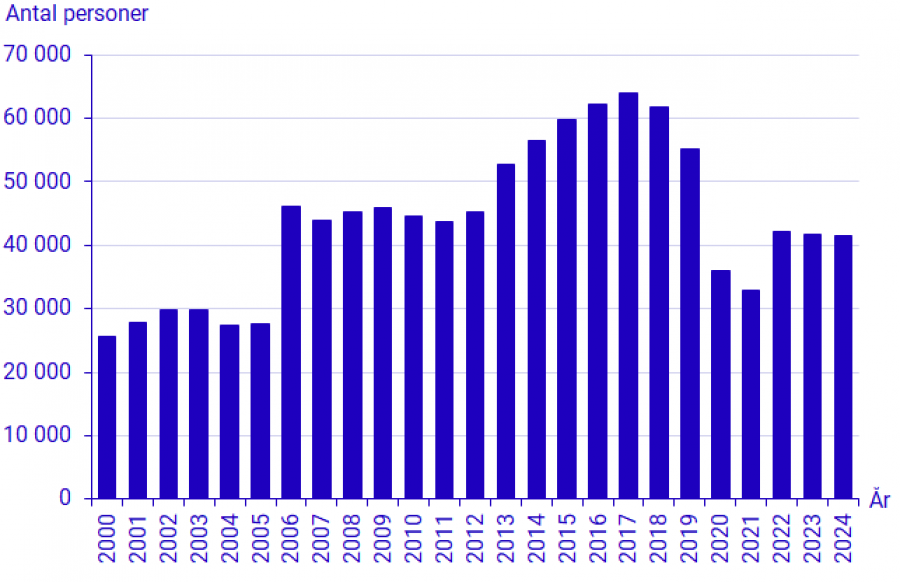Published 20 August 2024 at 18.05
Domestic. During the first half of 2024, Sweden's population increased by 1,600 people. This is the lowest population increase measured during six months in the 2000s – but the figures are strongly affected by the fact that the Swedish Tax Agency removes people who have emigrated from the registers. At the same time, immigration continues unabated – while the birth rate is still at a historic low.
Share the article
TwittraShare
During the 2000s, Sweden's population has grown, which can be explained by that more have been born than died, but above all that more have immigrated than emigrated.
– In recent years and the first half of 2024, fewer children have been born than in previous years, but the low population growth in 2024 is mainly due to the increase in the number of people registered as emigrants, says Ann-Marie Persson, population statistician at Statistics Norway, in a press release.
During the first half of 2024, 44,100 people were registered as emigrants, which is almost a doubling of the number of emigrants compared to previous years.
However, the increased emigration can largely be explained by administrative work at the Tax Agency. Since last year, the Tax Agency has been working to improve population registration by de-registering people who, during inspections, are found to no longer live in Sweden. In the population registers, these have largely been deregistered without a country of emigration being specified (in the statistics called unknown or non-existent country of emigration).
There may also be people who are covered by the Tax Agency's clearance work who are registered as having emigrated to an actual country and there are also people who have an unknown country of emigration that is not covered by the Tax Agency's checks. The extent of this, according to Statistics Norway, is not something that can be deduced from the data that forms the basis of the population statistics.
During the first half of 2024, 15,400 people who emigrated to an unknown country of emigration were deregistered. This corresponds to 35 percent of emigration during the period, which can be compared with the first half of 2023 where the proportion was 13 percent.
Even when counting the number of emigrants without including people who emigrated to an unknown or non-existent country, the number of emigrants is higher than before. During the first half of 2024, 28,700 people who emigrated to an actual country of emigration were registered. Compared to the first half of 2023, there is an increase of 5,700 people or 25 percent.
The largest emigrant group was people born in Sweden, followed by people born in India and Iraq. Emigration of people born in India increased the most in number compared to the first half of 2023. This is followed by people born in Sweden, China and Iraq.
Government: No evidence that a single immigrant has net emigrated:
The Migration Minister claims that thousands of Iraqis, Somalis and Syrians are "net emigrants" from Sweden.
But everything indicates that the real figure is 0 people. https://t.co/Rwa1wnAZ5H
— Fria Tider (@friatider) August 17, 2024
Immigration continues at the same level
In the first half of 2024, 41,400 people immigrated, which was one percent less or 309 people fewer compared to the same period in 2023. Immigration thus still does not appear to be decreasing from its historically high levels, despite the Tidö parties' promise of a “paradigm shift”.
The largest group of immigrants were people born in Sweden (5,200 people). Next come those born in Ukraine (4,700 people) and India (2,500 people).
Born in Ukraine is not only the second largest group of immigrants, but also the group that has increased the most compared to the first half of 2023. The immigration of people born in Ukraine has increased by 4,500 people. The increase is explained by the fact that people who came from Ukraine, and have had a residence permit with temporary protection for at least two years, have since June the opportunity to apply to be registered in Sweden.
Continued record low birth rate< /strong>
Childbirth in Sweden has had a downward trend for several years. That trend has continued during the first half of 2024. During the first six months of the year, 50,500 children were born, which was the lowest number of births in the first half of the year in 21 years. Compared to the first half of 2023, two percent fewer or 1,000 fewer children were born.
During the first half of 2024, 47,000 people died, which was 230 fewer than the same period the year before.
Lowest birth rate in Sweden ever:
New scary figures from Statistics Norway.
Worst fertility since statistics began to be kept in 1749. https://t.co/mkNhjyo6rR
— Fria Tider (@friatider) February 22, 2024
Fria Tider reported at the beginning of the year that fertility in Sweden in 2023 was the lowest since statistics began to be kept in 1749.
At the end of June 2024, 10,553,300 people were registered in Sweden.

© SCB
Number of immigrations during the first half of the year, 2000–2024. The Tidö government is taking in about as many immigrants as Fredrik Reinfeldt did during his time as prime minister – and there are no signs of the trend slowing down.

Leave a Reply
You must be logged in to post a comment.